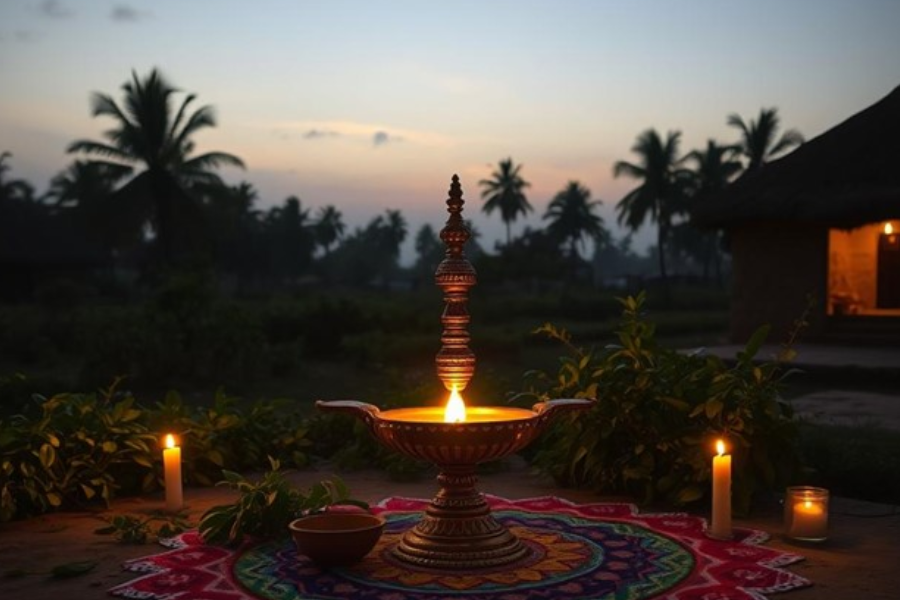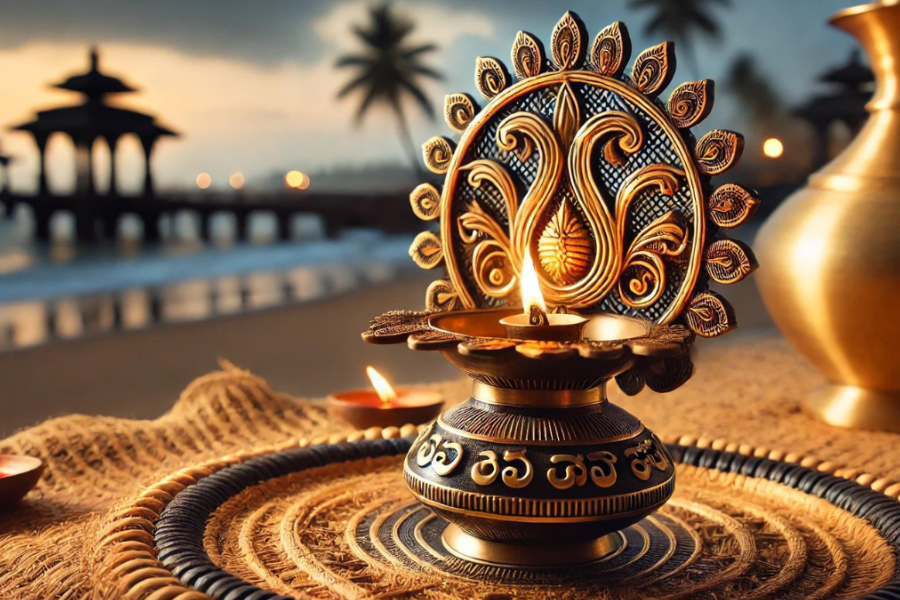The Vavilaku in Tulu: A Symbol of Light and Tradition Culture
The vavilaku in Tulu, a traditional oil lamp, holds significant cultural and spiritual meaning in Tulu culture. Far beyond its role as a mere source of light, the vavilaku in tuluembodies prosperity, spirituality, and a deep connection to the region’s heritage. This article delves into the vavilaku’s origins, its continued relevance in modern Tulu life, and its cultural and spiritual importance.
What is the vavilaku in tuluin Tulu Culture?
In Tulu culture, the vavilaku in tuluis more than just a traditional oil lamp; it is a symbol of spiritual illumination, prosperity, and divine blessings. This lamp holds a central place in both the physical and spiritual practices of the Tulu-speaking community. The act of lighting the vavilaku in tulutranscends its role as a mere source of light— it is a ritual that invites positivity, protects from evil forces, and connects the community to ancient spiritual traditions. Let’s explore the deeper meanings and cultural significance of the vavilaku.

The Spiritual Significance of the Vavilaku
At its core, the vavilaku in tulurepresents the triumph of light over darkness, both literally and metaphorically. Light has long been associated with knowledge, truth, and divine presence in various cultures, and the vavilaku in tuluis no exception. In Tulu culture, lighting the lamp is seen as an act of inviting spiritual enlightenment into one’s life. The flame symbolizes purity, knowledge, and clarity, while also providing protection against evil and negativity. The ritual of lighting the vavilaku in tulubrings a sense of peace and positivity, dispelling darkness from both the physical and spiritual realms.
A Symbol of Prosperity and Good Fortune
The vavilaku in tuluis also believed to bring material prosperity and good fortune to those who light it. In Tulu households, the lamp is often lit during important rituals and ceremonies, such as weddings, housewarming events, and festivals, with the belief that it will usher in wealth, health, and happiness. The act of lighting the vavilaku in tuluis thought to attract positive energy and divine blessings, ensuring that the individual or family experiences growth and success. It is a tangible symbol of the community’s deep connection to the forces of nature and the divine, reinforcing the belief that light is not only a physical phenomenon but a conduit for blessings.

The Role of the vavilaku in tuluin Rituals and Ceremonies
In Tulu culture, the vavilaku in tuluplays an indispensable role in various rituals and ceremonies. It is prominently featured in spiritual practices, marking the beginning of sacred events and inviting divine presence. During religious observances, such as pujas (prayer rituals) or festivals like Deepavali, the vavilaku in tuluis lit to offer light and purity to the gods. Its presence during these rituals helps create an atmosphere of sanctity and spiritual significance, guiding worshippers toward enlightenment and divine favor.
Material Symbolism and Evolution of the Vavilaku
The vavilaku in tuluhas also evolved in terms of its material form, reflecting the community’s progress and cultural adaptation over time. Originally crafted from simple earthenware, the lamp has transitioned to being made from more durable and valuable materials like brass and bronze. These materials not only enhance the lamp’s aesthetic value but also symbolize the community’s journey from simplicity to sophistication. Despite the evolution in its design, the core spiritual and cultural significance of the vavilaku in tuluremains unchanged. It continues to represent the connection between material wealth and spiritual well-being.

The vavilaku in tuluas a Cultural Heirloom
In many Tulu families, the vavilaku in tuluis treated as a precious heirloom, passed down through generations. Each lamp carries with it not only a history of family traditions but also the spiritual beliefs of the ancestors. The vavilaku in tuluis often kept as a cherished item in homes, reflecting the family’s reverence for their cultural heritage and spiritual practices. For many, lighting the vavilaku in tuluis not just a ritual, but an emotional and familial connection to their past, reinforcing the importance of cultural continuity and respect for ancestral wisdom.
The vavilaku in tuluin the Context of Tulu Identity
The vavilaku in tuluis a significant symbol of Tulu identity. It is deeply embedded in the region’s customs and plays a role in shaping the community’s shared spiritual and cultural worldview. In Tulu-speaking regions, the vavilaku in tuluserves as a reminder of the community’s connection to ancient traditions and the continuing relevance of those practices in modern life. By lighting the vavilaku, individuals affirm their identity and preserve the values that have been passed down for generations, ensuring that the essence of Tulu culture remains intact.
A Glimpse Into the Historical Significance of the Vavilaku
The vavilaku in tuluhas its roots in the agrarian past of the Tulu-speaking people. Originally crafted from simple clay, these early lamps served a practical purpose of illumination. Over time, as Tulu society progressed, the vavilaku in tulutransitioned into a more sophisticated form, made from metals like brass and bronze. These materials reflected the community’s growth and modernization. Today, many families in Tulu culture hold onto their vavilakus as cherished heirlooms, symbolizing both their cultural continuity and respect for tradition.
The Evolution of the Vavilaku: A Reflection of Change
As Tulu society evolved, so did the vavilaku. What started as a simple clay lamp has morphed into a refined cultural artifact, crafted from durable and visually striking metals. Despite these changes, the vavilaku in tuluremains deeply tied to Tulu identity, blending traditional practices with contemporary lifestyles. Its enduring significance serves as a testament to the resilience of Tulu culture in the face of modernization.
The Vavilaku’s Role in Tulu Festivals
The vavilaku in tuluis a central element in several key festivals in Tulu culture. It serves as a medium to bridge the material and spiritual worlds, inviting divine blessings and protection.
vavilaku in tuluin the Kambala Festival
One of the most prominent festivals in Tulu culture, Kambala, features traditional buffalo races that are preceded by a ritual involving the lighting of the vavilaku. The lamp is lit to seek divine blessings for a successful and auspicious event, setting a positive tone for the festivities.
vavilaku in tuluin Bhoota Kola
During Bhoota Kola, a traditional ritual to honor spirits and deities, the vavilaku in tuluplays a key role in inviting these spiritual entities. The light from the lamp is believed to provide guidance and protection, creating an atmosphere of harmony and balance. It reinforces the spiritual aspect of the festival, maintaining a positive connection between the participants and the divine.
Everyday Use and Symbolism of the Vavilaku
Outside of major festivals, the vavilaku in tulucontinues to hold significance in daily life. In many Tulu households, lighting the vavilaku in tuluat dusk is a common ritual. This practice is thought to bring good fortune, peace, and prosperity to the home, while also dispelling negative influences. The vavilaku in tuluis often placed in prayer rooms or near doorways, reinforcing its symbolism as a beacon of purity, wisdom, and the triumph of light over darkness.
The vavilaku in tuluin Special Ceremonial Occasions
The vavilaku, beyond its role in daily life and festivals, plays a crucial part in marking significant life events in Tulu culture. Its presence during weddings, housewarmings, and religious ceremonies is not just a tradition but a spiritual act that signifies new beginnings, blessings, and prosperity. Lighting the vavilaku in tuluduring these occasions is a meaningful ritual, believed to invoke divine favor and ensure success. Let’s explore the role of the vavilaku in tuluin these important ceremonies.
The vavilaku in tuluin Weddings
Weddings in Tulu culture are sacred ceremonies that bring together two families in union, and the lighting of the vavilaku in tulumarks the spiritual start of the journey ahead. The vavilaku in tuluis often placed at the wedding altar or near the couple, symbolizing the light of love, unity, and prosperity that the marriage will bring. As the vavilaku in tuluis lit, it is believed to bless the couple’s new life together, ensuring harmony, happiness, and a prosperous future. The light from the lamp serves as a guiding force for the couple, illuminating their path as they embark on their shared journey of life.
vavilaku in tuluin Housewarming Ceremonies
A housewarming ceremony is another pivotal moment in Tulu culture, and the vavilaku in tuluis an essential part of this ritual. When a family moves into a new home, the vavilaku in tuluis lit to purify the space and invite positive energy. It is believed that lighting the lamp drives away any negativity and invites divine protection for the new house. The lamp symbolizes the dawn of a new phase, where the home will be filled with warmth, happiness, and prosperity. The vavilaku’s light is seen as an auspicious sign, ensuring that the household will thrive and remain a sanctuary of peace.
vavilaku in tuluin Religious Observances
In addition to life milestones, the vavilaku in tuluplays a significant role in various religious observances. During pujas (prayer rituals) and other religious ceremonies, the vavilaku in tuluis lit as a symbol of divine presence and spiritual illumination. It is considered an offering of light to the deities, signifying purity and devotion. The lighting of the vavilaku in tuluduring these rituals is believed to purify the surroundings and create an atmosphere conducive to worship. It serves as a reminder of the eternal light of divinity, guiding worshippers toward spiritual growth and enlightenment.
The vavilaku in tuluas a Symbol of New Beginnings
Whether it is a wedding, a housewarming, or a religious ceremony, the lighting of the vavilaku in tulumarks a new chapter in life. It is a powerful symbol of fresh starts, divine favor, and positive energy. As the lamp burns brightly, it signifies the beginning of a new phase filled with hope, blessings, and abundance. The vavilaku’s glow offers comfort, as it is believed to chase away darkness and negativity, allowing only good things to enter into the lives of those celebrating these significant occasions.
The vavilaku in tuluin Contemporary Tulu Culture
Even in today’s modern age, the vavilaku in tulucontinues to be cherished in Tulu culture. During celebrations like Deepavali, the festival of lights, the vavilaku in tuluis still an integral part of Tulu homes and public spaces. This enduring tradition highlights how the vavilaku in tuluhas adapted to modern times while maintaining its cultural importance. It demonstrates the continuity of Tulu cultural practices amidst the changing dynamics of contemporary life.
Efforts to Preserve the vavilaku in tuluTradition
The vavilaku, as an integral part of Tulu culture, is a symbol of light, spirituality, and cultural heritage. However, with the rapid pace of modernization and changing lifestyles, there is a growing need to preserve this cherished tradition. Cultural organizations, community groups, and local leaders are taking active steps to ensure that the significance of the vavilaku in tulucontinues to be understood and appreciated by younger generations. These efforts are vital to maintaining the vavilaku’s relevance and ensuring that its cultural legacy is passed down to future generations.
Community Workshops and Cultural Programs
One of the most effective ways to preserve the vavilaku in tulutradition is through community workshops and cultural programs. These events are organized by local cultural associations, temples, and community centers to educate the younger population about the history and significance of the vavilaku. In these workshops, participants learn how to make and maintain the lamp, as well as the rituals associated with its use. The workshops often include storytelling sessions, where elders share their personal experiences and the spiritual importance of the vavilaku in tuluin their lives. By actively involving younger generations in these traditions, these programs foster a sense of connection to their cultural roots.
Educational Initiatives in Schools and Colleges
In addition to community workshops, educational institutions play an important role in preserving the vavilaku in tulutradition. Schools and colleges in Tulu-speaking regions have started to incorporate lessons about local customs and rituals into their curricula. Students are introduced to the history of the vavilaku, its role in festivals, and its deeper spiritual significance. Teachers and cultural experts work together to create interactive learning experiences, such as art projects where students create their own vavilakus or participate in mock ceremonies. These initiatives help students appreciate the value of their cultural heritage and encourage them to carry on the tradition in their daily lives.
Preserving the Craftsmanship of vavilaku in tuluMaking
The traditional craftsmanship involved in making the vavilaku in tuluis another focus of preservation efforts. Artisans who have mastered the art of crafting these lamps are passing down their skills to apprentices in an effort to keep the craftsmanship alive. Many communities organize training programs for aspiring artisans, teaching them how to create vavilakus from materials such as clay, brass, and bronze. By maintaining the skills necessary to produce these lamps, the tradition of the vavilaku in tuluremains tied to the craftsmanship of the past, ensuring that the physical object itself remains a symbol of cultural continuity.
Celebrating vavilaku in tuluDuring Festivals
Cultural events and festivals continue to play a significant role in the preservation of the vavilaku in tulutradition. During festivals like Deepavali, Kambala, and Bhoota Kola, the vavilaku in tuluis not only used in rituals but also highlighted as a symbol of cultural pride. Many festivals now include special sessions focused on the vavilaku, where community members showcase its importance and teach others about its meaning. Public processions and performances also feature the vavilaku in tuluas a central element, reminding people of its role in spiritual and cultural life. These celebrations provide an opportunity for families to come together, share knowledge, and celebrate the ongoing importance of the vavilaku in tuluin contemporary Tulu culture.

FAQs
Q: What is the significance of the vavilaku?
A: The vavilaku in tuluis a traditional oil lamp in Tulu culture, symbolizing light, prosperity, and divine blessings. It is used in various rituals and daily practices to invite positive energy and dispel negativity.
Q: How did the vavilaku in tuluevolve over time?
A: Originally crafted from clay, the vavilaku in tuluevolved with the modernization of Tulu society, moving to more durable materials like brass and bronze. This shift reflects the community’s growth and adaptation to contemporary life.
Q: What role does the vavilaku in tuluplay in festivals?
A: In Tulu festivals such as Kambala and Bhoota Kola, the vavilaku in tuluis lit to invoke divine blessings and protection, playing a key role in the spiritual rituals that connect the physical and spiritual realms.
Q: How is the vavilaku in tuluused in daily life?
A: In daily life, the vavilaku in tuluis lit at dusk in many Tulu households to bring prosperity, peace, and ward off negative energies. It is typically placed in prayer rooms or near doorways to symbolize purity and spiritual guidance.
Q: Why is the vavilaku in tuluused in special occasions?
A: The vavilaku in tuluis used during important life events such as weddings and housewarmings to bless the occasions with success and abundance. Its presence is seen as an auspicious sign that ensures the event is filled with positivity and divine favor.
Conclusion
The vavilaku in tuluis much more than an oil lamp in Tulu culture; it is a symbol of light, divine presence, and cultural continuity. From its humble beginnings in agrarian times to its place in modern celebrations, the vavilaku in tulucontinues to be an enduring symbol of prosperity and spiritual well-being. Its role in festivals, daily rituals, and special occasions reflects the deep connection the Tulu people have with their traditions, ensuring that this cherished cultural artifact remains a living part of their heritage.
Stay tuned and alert for more updates! The App Kod







